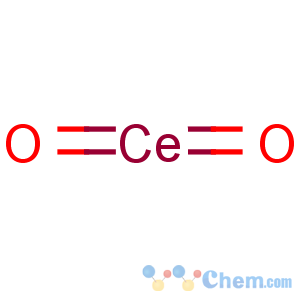Title: Ceric Oxide
CAS Registry Number: 1306-38-3
Synonyms: Ceria
Molecular Formula: CeO2
Molecular Weight: 172.11
Percent Composition: Ce 81.41%, O 18.59%
Literature References: Prepn from Ce salts: Duval,
Anal. Chim. Acta 1, 341 (1947); other prepns: Warf,
US 2564241 (1951 to USAEC); Wilke,
Z. Anorg. Allg. Chem. 330, 164 (1964). Purification: Wetzel in
Handbook of Preparative Inorganic Chemistry vol. 2, G. Brauer, Ed. (Academic Press, New York, 2nd ed., 1965) pp 1132-1135.
Review: Davis, Wayman,
Can. Chem. Process Ind. 29, 230 (1945). Toxicity data: C. E. Lambert
et al., J. Am. Coll. Toxicol. 12, 617 (1993).
Properties: Heavy powder or cubic crystals; white if pure, but usually pale yellow; traces of lanthanum, praseodymium, etc., give a pink to reddish-brown color. Practically insol in water, acids. LD50 orally in rats: >5.0 g/kg (Lambert).
Toxicity data: LD50 orally in rats: >5.0 g/kg (Lambert)
Use: Polishing and decolorizing glass; as opacifier for vitreous enamels; in heat-resistant alloy coatings; in coatings for infrared filters to prevent reflection; in analysis for Ce and oxidimetry; as catalyst for organic reactions.

